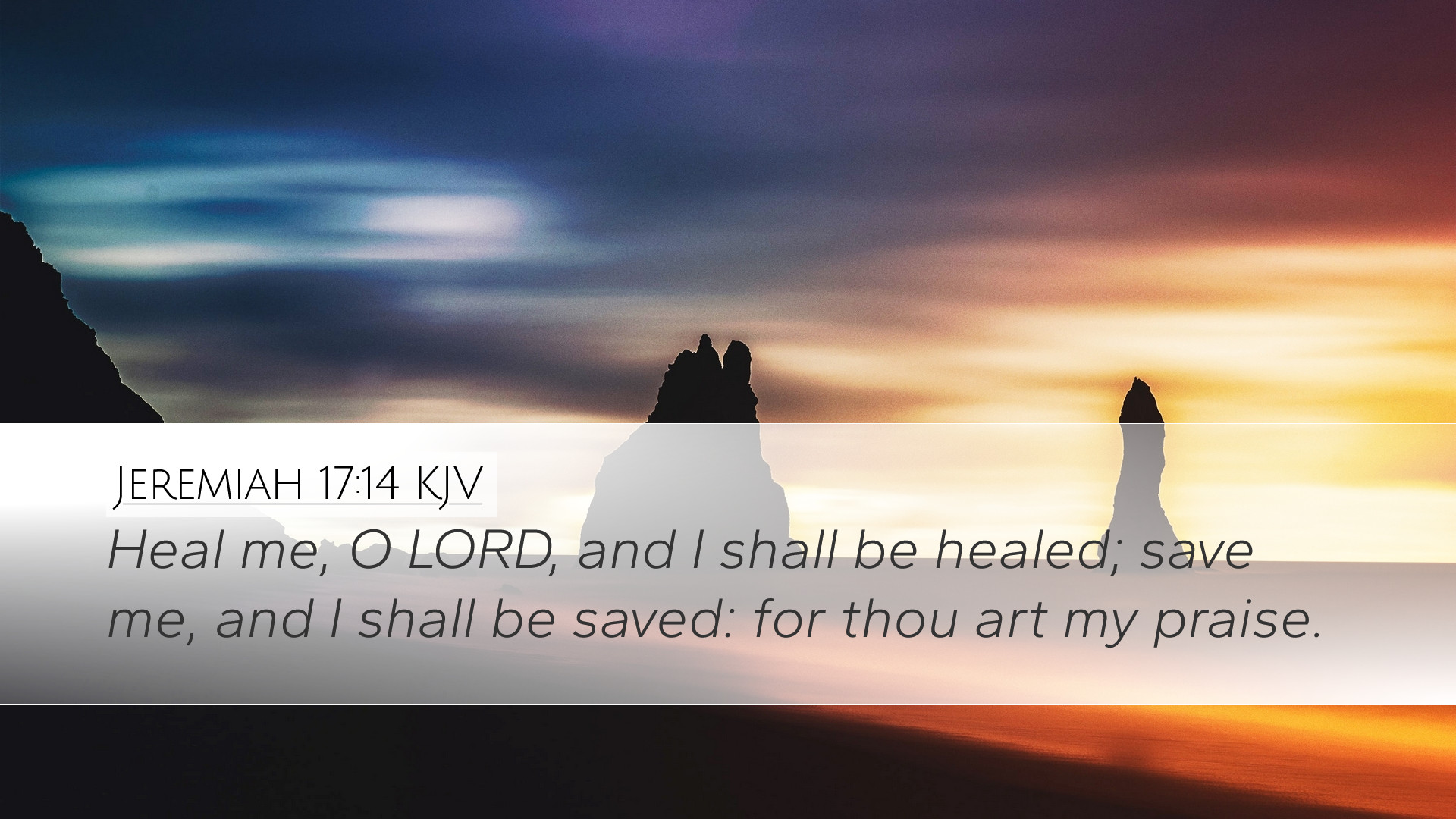Commentary on Jeremiah 17:14
Jeremiah 17:14 states:
"Heal me, O Lord, and I shall be healed; save me, and I shall be saved: for thou art my praise."
This verse offers a profound reflection on the themes of healing and salvation, expressed through a heartfelt plea to God. The essence of this petition reveals insights into the nature of faith, divine intervention, and the human condition.
Background and Context
Jeremiah, often referred to as the "weeping prophet," ministered during a tumultuous period in Israel's history. His prophecies often centered on the impending doom of Judah due to widespread sin, idolatry, and refusal to return to God. In the midst of judgment, however, Jeremiah's call for healing presents a glimmer of hope, emphasizing that God remains a source of restoration.
Thematic Insights
The claim for healing and salvation in this verse encapsulates several key themes:
- The Acknowledgment of Need: Jeremiah acknowledges his need for both physical and spiritual restoration.
- Faith in Divine Power: The petition reflects a deep faith in God's ability to heal.
- Praise as a Response: The verse concludes with a declaration of praise, indicating that healing leads to worship.
Acknowledgment of Need
Jeremiah's desperation is evident as he calls out to God for healing. This recognition of need is essential in biblical teaching; it aligns with the doctrine of humility before God's sovereignty. According to Matthew Henry, “There can be no true healing until there is an acknowledgment of the ailment.” This sentiment drives the believer to seek divine intervention rather than rely on human efforts.
Faith in Divine Power
The phrase “Heal me, O Lord” is a powerful invocation of faith. Albert Barnes highlights that this statement underlines the belief that only God possesses the true power to restore. This reliance on God for healing can challenge believers today to move their focus from self-reliance to divine dependency.
Praise as a Response
The concluding thought of “for thou art my praise” suggests that healing results in transformed lives that respond to God's goodness with worship. Adam Clarke notes that true gratitude is evidenced in praise rather than mere lip service. The healing process augments the believer's faith, prompting outward expressions of appreciation to God.
Interpretation and Application
Interpreting this verse involves recognizing the dual aspects of healing: physical and spiritual. The plea for healing can be applied both to personal circumstances of illness and to the broader spiritual state of one’s life.
Physical Healing
In times of illness, believers can echo Jeremiah’s cry, understanding that God is capable of physical restoration. Henry reflects on the importance of faith-based petitions in the context of community prayer and invokes James 5:14, which encourages the sick to call for the elders for healing. This practice remains crucial for the church today.
Spiritual Healing
On a spiritual level, this verse becomes a mirror reflecting the need for ongoing repentance and restoration of one's relationship with God. Barnes emphasizes that spiritual healing relies on recognizing sin and returning to a place of obedience. “O Lord, save me” denotes not only deliverance from sin but also the transformative power of grace.
The Nature of God as Healer
In summoning God to act as healer, Jeremiah affirms key attributes of God, encapsulated in the Old Testament understanding of 'Yahweh Rapha' (the Lord who heals). This theological foundation indicates that healing is not merely a happenstance of divine mercy but a key aspect of God’s character.
Divine Compassion and Accessibility
The appeal to God suggests His accessibility and compassionate nature. Adam Clarke states, “God’s ears are ever open to His people’s cries.” This higher view of God's readiness to respond can foster a robust prayer life among believers, emphasizing fervent communication.
The Covenant Relationship
The healing invoked also aligns with the covenant relationship between God and His people. The Hebrew scriptures indicate that God's desire is for His people to be whole. Henry points out that the blessings associated with covenant fidelity often manifest in both physical wellbeing and spiritual wholeness.
Conclusion
Jeremiah 17:14 stands as a poignant reminder of the necessity of seeking divine intervention in our lives. Both pastors and scholars alike can derive rich applications from the layers of meaning inherent in this verse. It urges believers not only to voice their needs before God but also to recognize the profound relationship forged through faithfulness and healing.
By blending acknowledgment of need, faith in God's power, and resulting praise, individuals are invited into a cycle of divine encounter—one that is transformative in both personal and communal contexts. Ultimately, this verse encourages the church to make healing a vital part of worship and communal life, adhering to the promise that the Lord is ever near, ready to heal and save.


